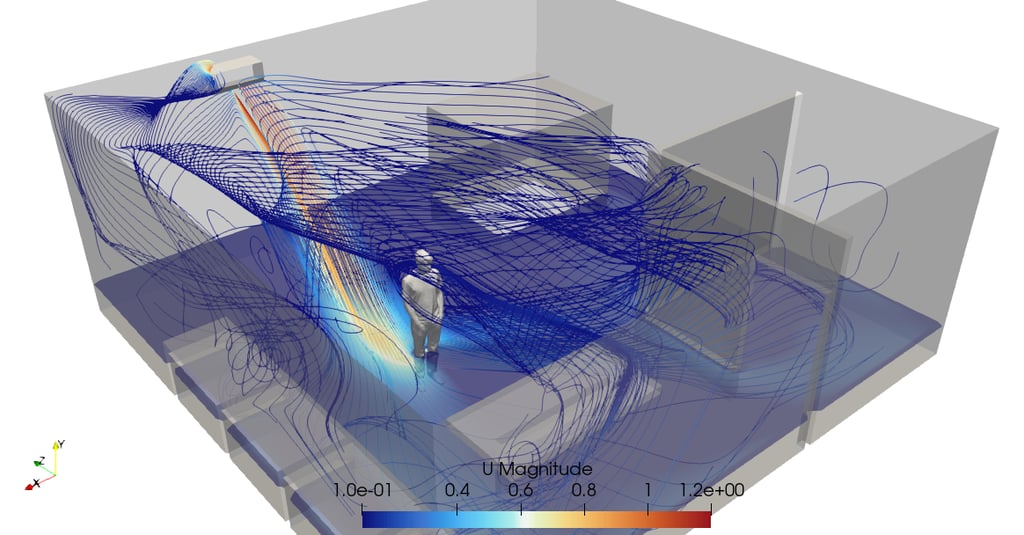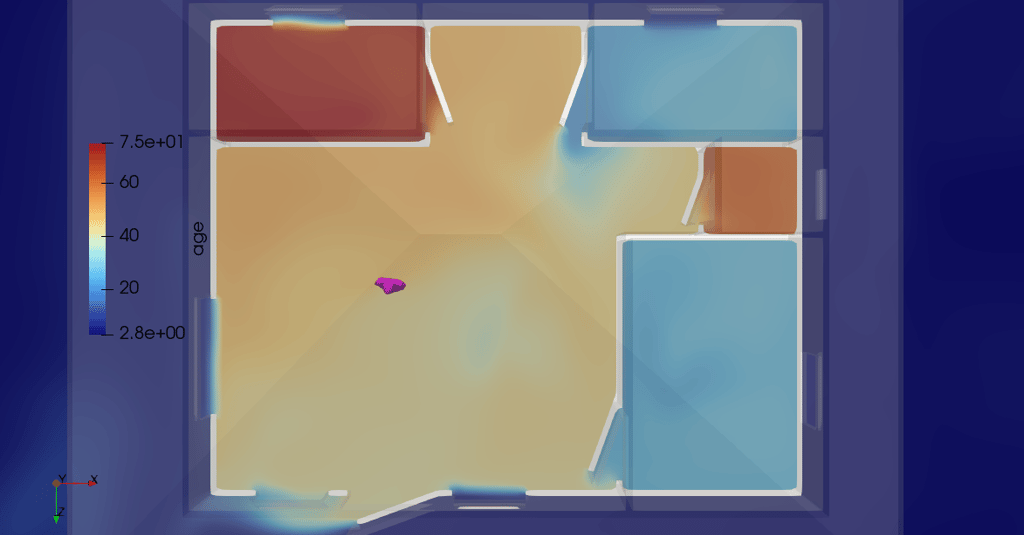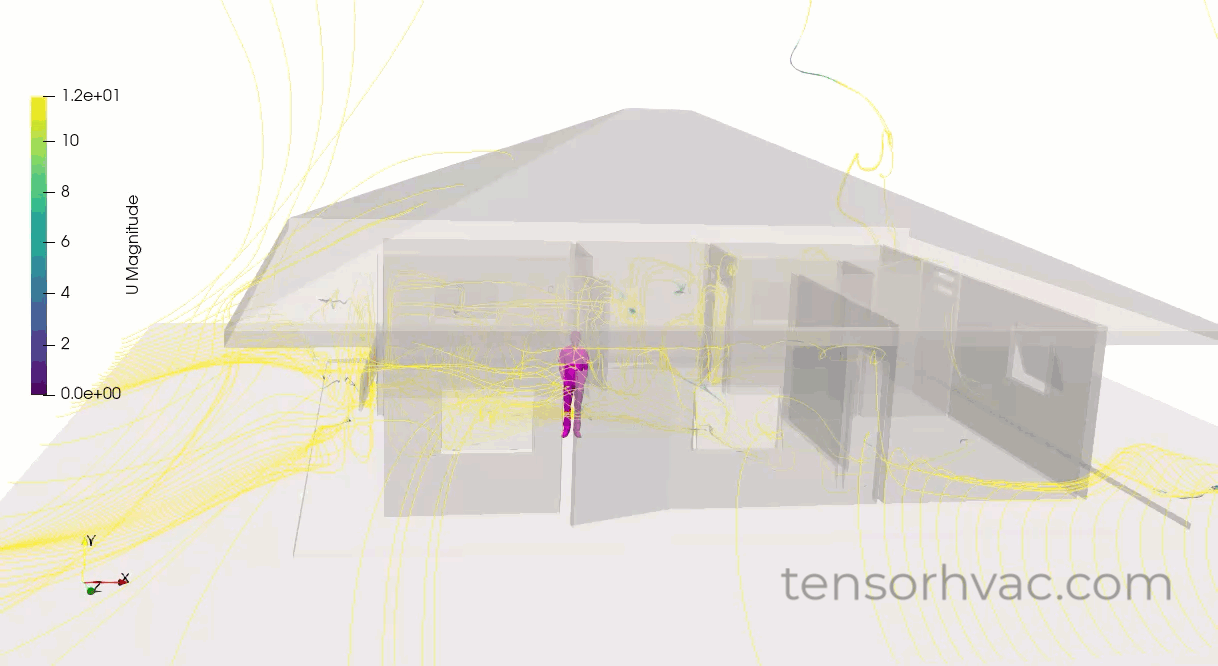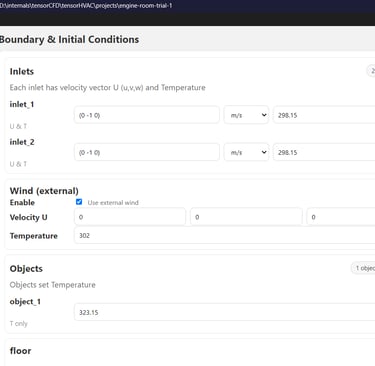HVAC Simulation Software
How engineers using Computational Fluid Dynamics software to simulate flow and thermal, also comfort of Heating Ventilation and Air Conditioning System
ARTICLES
Wiratama
10/25/20256 min read


HVAC Simulation Software: Optimizing Indoor Comfort with Computational Fluid Dynamics
In modern building design, achieving optimal indoor comfort, air quality, and energy efficiency is no longer based on guesswork. Engineers and architects now rely on HVAC simulation — the use of advanced numerical modeling to predict how air moves, mixes, and behaves inside buildings. Using Computational Fluid Dynamics (CFD) as the core engine, HVAC simulation software helps professionals visualize invisible parameters like temperature gradients, air velocity, humidity distribution, and pollutant dispersion.
This digital approach not only reduces design errors but also ensures compliance with international standards such as ASHRAE 55, 62.1, and 90.1, which define acceptable thermal comfort, indoor air quality, and energy performance. In this article, we explore how HVAC simulation works, its advantages, typical applications, and the emerging role of specialized CFD-based tools like tensorHVAC-Pro.
Understanding HVAC Simulation
HVAC Simulation is the process of creating a virtual representation of an indoor space or ventilation system to analyze airflow and heat transfer phenomena. It helps engineers predict performance before physical installation, minimizing costly rework. By using computational models, engineers can evaluate how design choices—such as diffuser type, vent location, or equipment capacity—affect indoor comfort and system efficiency.
The core of any HVAC simulation tool is Computational Fluid Dynamics (CFD). CFD solves the fundamental equations governing fluid motion (the Navier-Stokes equations) to predict velocity, temperature, pressure, and other variables at every point in the domain. In HVAC applications, CFD allows designers to observe how conditioned air circulates, where it stagnates, and how efficiently it reaches occupants.
Modern HVAC simulation software combines CFD with thermodynamics, radiation modeling, and occupant comfort equations to provide a complete picture of indoor environmental performance. This integrated approach helps bridge the gap between mechanical design and real-world comfort.
The Role of Computational Fluid Dynamics (CFD) in HVAC
At the heart of HVAC simulation lies Computational Fluid Dynamics, a numerical method that transforms physical equations of fluid motion into solvable digital models. In HVAC design, CFD is used to simulate air distribution, temperature stratification, contaminant transport, and energy exchange.
A CFD-based HVAC simulation typically follows these steps:
Geometry Creation – The building space, ducts, and diffusers are modeled in 3D using CAD or BIM tools.
Mesh Generation – The space is divided into small computational cells where governing equations are solved.
Boundary Conditions – Air inlet velocity, temperature, heat sources, and material properties are defined.
Solver Execution – CFD algorithms compute airflow, turbulence, and thermal fields iteratively.
Post-Processing – Results are visualized using contour plots, streamlines, and comfort maps.
Through these stages, engineers gain valuable insights such as temperature uniformity, ventilation effectiveness, and the impact of obstructions on air movement. CFD also enables parametric analysis, allowing multiple design options to be tested under varying load or occupancy scenarios.


Key Benefits of HVAC Simulation
1. Improved Indoor Comfort
CFD-driven HVAC simulation enables precise control over comfort variables such as air temperature, velocity, humidity, and draft rate. Comfort metrics like PMV (Predicted Mean Vote), DR (Draught Rate), and PD (Percentage Dissatisfied) can be calculated to ensure the system performs within ASHRAE 55 comfort standards.
2. Energy Efficiency Optimization
Traditional design methods often oversize HVAC systems to ensure performance, which wastes energy. By using HVAC simulation, engineers can identify zones of overcooling or overheating and balance airflows accordingly. Optimizing diffuser layouts and airflow patterns reduces fan power and improves system efficiency, helping meet ASHRAE 90.1 requirements.
3. Better Indoor Air Quality (IAQ)
Ventilation standards such as ASHRAE 62.1 emphasize maintaining healthy indoor air. HVAC simulation helps visualize contaminant dispersion, CO₂ accumulation, and airflow paths that might cause recirculation of stale air. CFD results can guide placement of return vents and filters to enhance IAQ and occupant health.
4. Reduced Design Risk and Cost
By virtually testing the design before construction, HVAC simulation reduces trial-and-error during commissioning. Potential issues such as dead zones, uneven temperatures, or drafts can be corrected early, minimizing modification costs.
5. Validation for Green Building Certification
Many sustainable design programs (e.g., LEED, WELL, BREEAM) recognize simulation as a performance-based compliance method. CFD-based HVAC analysis can demonstrate ventilation effectiveness, thermal comfort, and natural ventilation performance for certification credits.


Applications of HVAC Simulation in Building Design
1. Commercial and Office Buildings
Office spaces require uniform comfort and low noise levels. HVAC simulation ensures proper diffuser arrangement and evaluates occupant comfort under various loading conditions. CFD can predict how rearranging partitions or ceiling layouts affects ventilation performance.
2. Data Centers
Thermal management is critical in data centers. HVAC simulation predicts air temperature around servers, preventing hotspots and ensuring energy-efficient cooling strategies such as containment or underfloor supply systems.
3. Hospitals and Laboratories
Contaminant control is vital in healthcare environments. CFD-based HVAC simulation evaluates airflow paths to minimize cross-infection risks and maintain cleanroom classifications. It can simulate air curtains, pressure differentials, and filtration efficiency.
4. Industrial Facilities
Large workshops and factories often face uneven air distribution due to high ceilings and heat loads. HVAC simulation helps design displacement ventilation or evaporative cooling systems that ensure worker comfort and efficient air exchange.
5. Residential and Smart Buildings
Modern homes and smart buildings integrate ventilation, heating, and cooling systems with sensors. Simulation helps predict how changing occupancy or outdoor conditions affects comfort and energy consumption.
Integrating HVAC Simulation into Design Workflow
Traditionally, HVAC design relied on empirical formulas and simplified load calculations. While these methods provide initial sizing, they lack insight into actual air distribution and thermal behavior. Integrating CFD-based HVAC simulation early in the design stage bridges this gap.
Designers can import architectural geometry from BIM tools, define boundary conditions, and run multiple scenarios to refine system layout. Visualization of results — such as velocity contours and temperature maps — allows both engineers and clients to understand the design’s performance intuitively.
By incorporating simulation feedback before construction, the design process becomes iterative and data-driven. It leads to faster decision-making, reduced rework, and systems that perform closer to predicted energy models.
tensorHVAC-Pro: CFD-Driven HVAC Simulation for Real-World Design
tensorHVAC-Pro represents the next generation of HVAC simulation software, built specifically for engineers who demand accuracy and speed. Powered by advanced Computational Fluid Dynamics (CFD) algorithms, TensorHVAC-Pro enables users to simulate complex airflow and thermal environments within minutes.
The software integrates flow, thermal, and comfort analysis into one platform. Users can visualize air velocity distribution, temperature gradients, and air-age maps while simultaneously calculating PMV, DR, and PD indices in compliance with ASHRAE 55 and ISO 7730.
Unlike traditional HVAC tools that rely solely on empirical models, TensorHVAC-Pro uses real fluid dynamics to capture the detailed behavior of air movement around occupants, diffusers, and obstructions. Engineers can test alternative diffuser configurations, compare different ventilation strategies (mixing vs. displacement), and quickly identify design improvements.
tensorHVAC-Pro’s automated meshing and solver optimization make CFD accessible even for non-specialists, while its reporting tools generate professional documentation aligned with international standards. Whether it’s an office, hospital, or industrial facility, the software delivers actionable insights to ensure comfort, compliance, and efficiency.


The Future of HVAC Simulation
As the construction industry embraces digital transformation, HVAC simulation will continue to evolve alongside technologies like AI, IoT, and digital twins. Future CFD-based tools will integrate real-time sensor data to dynamically adjust ventilation rates or detect thermal anomalies.
Machine-learning algorithms will further accelerate CFD computations, making predictive comfort analysis available in early concept design stages. With growing global emphasis on sustainability, the ability to virtually optimize HVAC performance will become a necessity rather than an option.
Conclusion
HVAC simulation powered by Computational Fluid Dynamics (CFD) has become an essential part of modern building design. It empowers engineers to visualize airflow, temperature, and comfort metrics before construction, ensuring energy-efficient, healthy, and comfortable indoor spaces.
Software like tensorHVAC-Pro makes these capabilities accessible to HVAC professionals worldwide, enabling them to comply with standards, reduce costs, and deliver superior occupant comfort. As simulation technology advances, CFD-driven HVAC design will continue to shape the future of sustainable buildings — transforming how we understand and control the air we live in.
Read other articles
